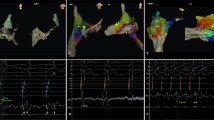Abstract
Introduction
Radiofrequency catheter ablation (RFCA) is a safe and effective treatment option for children with refractory supraventricular tachycardias. RFCA of right-sided accessory pathways (APs) continues to be challenging, resulting in lower success rates and higher recurrence rates. One of the reasons for a prolonged or failed procedure is mapping error and changes in cardiac anatomy. The right coronary artery (RCA) runs along the ventricular aspect of the right epicardial atrioventricular groove, and RCA mapping had been reported facilitating difficult right-sided AP RFCA in the pediatric population. We reported that microcatheter-assisted mapping during RFCA can improve localization of right-sided and some left-sided APs particularly in children with congenital heart disease.
Methods
This technique was used in seven patients with a mean age of 15.3 ± 1.6 years and a mean weight of 52.6 ± 6.5 kg. Five patients (71%) had manifest preexcitation on surface electrocardiogram, and two patients had a concealed AP. In two of them, there were single ventricle anatomies. In the other two patients, venous access problem to the heart and enormous cardiac hypertrophy were the major problems. In the remaining three patients with normal cardiac anatomy, RCA mapping was used because a standard procedure was not successful. Previous RFCA ablation was not successful in two patients. Either a 150-cm eight-electrode pair (2–6–2 mm, 2.5 French) or a four-electrode pair (2–6–2 mm, 2.3 French) microcatheter (2.3 French octapolar microcatheter) was used.
Results
Average time of the multielectrode RCA mapping was 42 ± 14.5 min. All eight (100%) APs were successfully ablated. No complications occurred.
Conclusions
Microcatheter-assisted coronary artery mapping during RFCA is a useful adjunctive mapping technique in children with difficult to map right-sided APs and patients with APs who has complex cardiovascular anomalies.



Similar content being viewed by others
References
Kugler, J. D., Danford, D. A., Deal, B., Gillette, P., Perry, J., Silka, M., et al. (1994). Radiofrequency catheter ablation for tachyarrhythmias in children and adolescents. New England Journal of Medicine, 330, 1481–1487.
Kugler, J. D., Danford, D. A., Houston, K., Felix, G., & Members of the EP Society. (1997). Radiofrequency Catheter Ablation Registry: radiofrequency catheter ablation for paroxysmal supraventricular tachycardia in children and adolescents without structural heart disease. American Journal of Cardiology, 80, 1439–1443.
Kugler, J. D., Danford, D. A., Houston, K. A., & Felix, G. (2002). Pediatric Radiofrequency Ablation Registry of the Pediatric Radiofrequency Ablation Registry of the Pediatric Electrophysiology Society: pediatric radiofrequency catheter ablation registry success, fluoroscopy time, and complication rate for supraventricular tachycardia: comparison of early and recent eras. Journal of Cardiovascular Electrophysiology, 13, 336–341.
Anderson, R. H., & Ho, S. Y. (1997). Anatomy of the atrioventricular junctions with regard to ventricular preexcitation. Pacing and Clinical Electrophysiology, 20, 2072–2076.
Cappato, R., Schluter, M., Weiß, C., Antz, M., Koschyk, D. H., Hofmann, T., et al. (1996). Radiofrequency current catheter ablation of accessory atrioventricular pathways in Ebstein’s anomaly. Circulation, 94, 376–383.
Shah, M. J., Jones, T. K., & Cecchin, F. (2004). Improved localization of right-sided accessory pathways with microcatheter-assisted right coronary artery mapping in children. Journal of Cardiovascular Electrophysiology, 15, 1238–1243.
Van Hare, G. F., Javitz, H., Carmelli, D., Saul, J. P., Tanel, R. E., Fischbach, P. S., et al. (2004). Pediatric Electrophysiology Society: prospective assessment after pediatric cardiac ablation: demographics, medical profiles, and initial outcomes. Journal of Cardiovascular Electrophysiology, 15, 759–770.
Van Hare, G. F., Dubin, A. M., & Collins, K. K. (2002). Invasive electrophysiology in children: state of the art. Journal of Electrocardiology, 35, 165–174.
Campbell, R. M., Strieper, M. J., Frias, P. A., Jeager, G., Balfour, G., Costello, L., et al. (2005). Quantifying and minimizing radiation exposure during pediatric cardiac catherization. Pediatric Cardiology, 26, 29–33.
Fishberger, S. B., Hernandez, A., & Zahn, E. M. (2009). Electroanatomic mapping of the right coronary artery. Journal of Cardiovascular Electrophysiology, 20(5), 526–529.
Bertram, H., Bökenkamp, R., Peuster, M., Hausforf, G., & Thomas, P. (2001). Coronary artery stenosis after radiofrequency catheter ablation of accessory atrioventricular pathways in children with Ebstein’s malformation. Circulation, 103, 538–543.
Author information
Authors and Affiliations
Corresponding author
Additional information
The work is performed in Hacettepe University Faculty of Medicine, Division of Pediatric Cardiology, Ankara, Turkey.
Rights and permissions
About this article
Cite this article
Olgun, H., Karagoz, T. & Celiker, A. Coronary microcatheter mapping of coronary arteries during radiofrequency ablation in children. J Interv Card Electrophysiol 27, 75–79 (2010). https://doi.org/10.1007/s10840-009-9445-0
Received:
Accepted:
Published:
Issue Date:
DOI: https://doi.org/10.1007/s10840-009-9445-0




